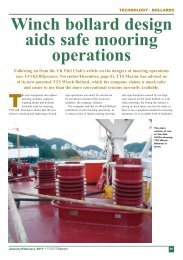Two-way tiltable ramps MARINE - TTS Group ASA
Two-way tiltable ramps MARINE - TTS Group ASA
Two-way tiltable ramps MARINE - TTS Group ASA
Create successful ePaper yourself
Turn your PDF publications into a flip-book with our unique Google optimized e-Paper software.
SHIPBOARD<br />
HANDLING<br />
EXCELLENCE<br />
www.ttsgroup.com<br />
<strong>Two</strong>-<strong>way</strong> <strong>tiltable</strong> <strong>ramps</strong><br />
Greater flexibility of vehicular mobility between two different deck levels is provided by<br />
<strong>TTS</strong> <strong>tiltable</strong> <strong>ramps</strong> which are provided with flaps and hinge facilities at both ends. With<br />
this arrangement, the hinge, at either its forward or aft end, as required, can be secured<br />
to the upper of the two decks, allowing the opposite end to be lowered to the other<br />
deck. This capability allows loading and unloading to take place in either direction along<br />
the ramp according to operational requirements.<br />
<strong>MARINE</strong>
T WO-WAY TILTABLE RAMPS<br />
This type of <strong>TTS</strong> internal ramp<br />
is arranged as a single section<br />
with flaps and is operated either<br />
by wire or direct-acting cylinder.<br />
Irrespective of which end it is<br />
hinged, the ramp can be raised<br />
or lowered while carrying its full<br />
load of vehicles.<br />
Examples of normal maximum<br />
slope for different types of<br />
vehicles are:<br />
• private cars 8–9.5 deg (1:6)<br />
• trailers 7.1 deg (1:8)<br />
• translifters 5.7 deg (1:10), etc.<br />
and therefore the ramp angle<br />
must not be greater than<br />
that required for the type of<br />
vehicle(s) the vessel carries.<br />
In meeting this slope angle<br />
requirement, the vertical<br />
distance between the two deck<br />
levels is taken into consideration<br />
when determining the ramp’s<br />
length. <strong>TTS</strong> <strong>tiltable</strong> <strong>ramps</strong> can be<br />
constructed as a single panel of<br />
sufficient length to meet these<br />
requirements. In addition to<br />
the end flaps, the design also<br />
Closed<br />
Open – either for or aft<br />
features facilities at the ramp<br />
ends to smooth the passage of<br />
vehicles on and off the ramp,<br />
and to prevent grounding of<br />
long vehicles.<br />
When stowed in its raised,<br />
horizontal position, the ramp<br />
fits flush with the surrounding<br />
deck, and is hydraulically locked<br />
and cleated. In this mode it<br />
acts as a hatch cover and can<br />
be watertight and gastight. The<br />
end flaps are stowed below<br />
the forward and after ends of<br />
the deck aperture, allowing<br />
watertightness of the ramp<br />
to be achieved by means of a<br />
sealing bar on the ramp section<br />
compressing a gasket located<br />
in the coaming. If required the<br />
flaps may be detached and<br />
stowed in recesses in the deck<br />
below. In common with the<br />
surrounding deck, the ramp is<br />
structurally dimensioned for<br />
seagoing conditions.<br />
The ramp features a full outfit<br />
of safety equipment including<br />
sensors to indicate when it is<br />
locked and cleated. Guides,<br />
supports and an anti-skid<br />
surface on the drive<strong>way</strong>, and<br />
kerbs with railings provide<br />
safe movement of vehicles and<br />
personnel on the ramp.<br />
Typical arrangement showing<br />
two-<strong>way</strong> operation of the<br />
<strong>tiltable</strong> ramp<br />
www.ttsgroup.com


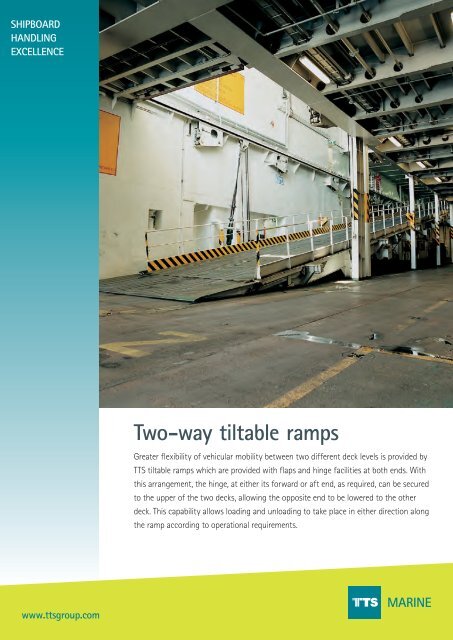


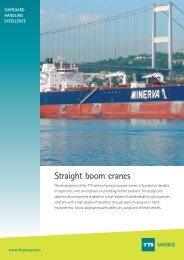

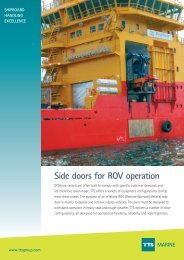
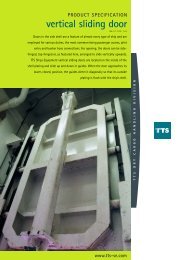



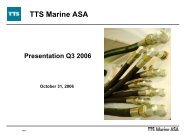
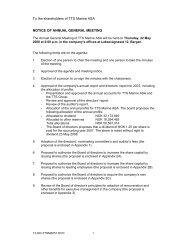
![2012.MasterPresentation_final [Compatibility Mode] - TTS Group ASA](https://img.yumpu.com/4612021/1/190x146/2012masterpresentation-final-compatibility-mode-tts-group-asa.jpg?quality=85)


